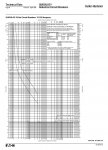Angel Electric
Member
- Location
- OBX, NC.
I had a call Where the customer was using a coffee maker and a waffle iron which as bath are on ,they drag 24.9 amps. The breaker is a 20amp sqaureD bout in type qo. Customer wants to know why circuit breaker is not tripping. I dont know at What range it should've... Any experience with the threshhold of circuit breakers will be greatly appreciated....

